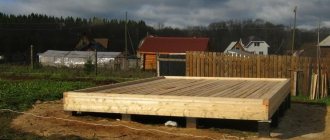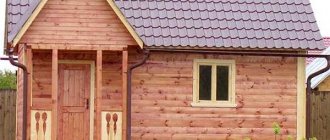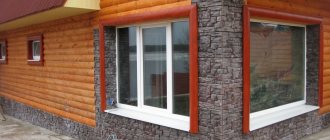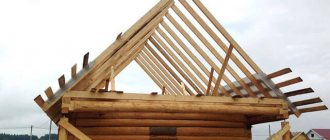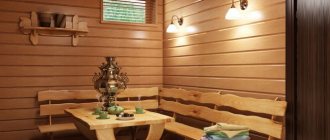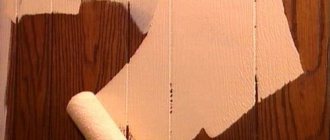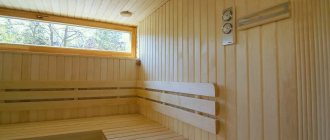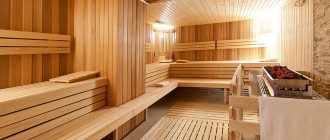How to sew up a roof gable: types of materials for sewing
Pediment-end wall of a house under the roof eaves
The roof is done, the gables can be sewn up.
How to sew up the gables of the roof so that they last a long time, so that they do not require annual maintenance or repairs, and so that the appearance is attractive?!
First, let’s remember what gables were sewn up with in the old days:
- unedged board
- edged board
- clapboard
The last option was the most scarce in Soviet times, and people with good salaries and great connections could afford to cover the gables with clapboard.
In the villages, no one bothered with beauty and design: they covered it with a simple unedged board or slab. The attic space is closed from wind and snow, which means everything is fine.
The lining with boards was done vertically, horizontally or diagonally. The herringbone looked good: short boards diagonally towards each other.
It is clear that over time the wood turned black from moisture and lost its natural color, so the townspeople who looked after the appearance of a house or bathhouse tried to paint wooden surfaces. But previously there were no special antiseptic compounds, so it was often lime or oil paint, which needed to be updated from time to time.
Now, with the advent of modern wooden and plastic materials, as well as new various painting compositions for wood, various options for lining gables are possible:
- edged board
- wooden clapboard
- block house
- plastic lining
- vinyl siding
Recommendations for selecting siding
Rice.
11. The house is covered with facade panels, and the pediment is covered with siding to match the main finish. Any type of siding is suitable for cladding the pediment: wood, metal, fiber cement or polymer (PVC siding or polypropylene facade panels). The advantages and disadvantages of each of them are shown in the table.
Wood siding
Metal siding
Fiber cement siding
Polymer siding
Wood absorbs moisture, this spoils its appearance and performance characteristics.
Under normal conditions, metal siding is not afraid of water. But if the protective coating is damaged, it may rust.
Resistant to moisture.
Resistant to moisture.
Corrosion, incl. biological
Susceptible to infection by fungi and mold.
If the protective layer is damaged, it may rust.
If wood has absorbed moisture when it freezes, it will deteriorate.
Article on the topic: Is it possible to heat a bathhouse on Ivana Kupala?
You can sew up the pediment with a lining made of PVC material
Plastic materials (lining or siding) are attractive because once you do the siding correctly and then forget about it. Covering the pediment with PVC clapboard guarantees the absence of any further painting work, which is usually necessary for wood every one to two years to maintain its antiseptic properties. PVC materials under normal operating conditions do not lose their attractive appearance for many, many years.
Correct installation of PVC materials is:
- mandatory gaps for linear expansion of PVC elements in hot weather
- mandatory gap between the sheathing and the main wooden structures for ventilation
But PVC lining or siding are afraid of open fire. Therefore, you cannot place a barbecue close or carry out any work using a gas burner: the siding loses its shape, melts and shrinks.
This is an extreme case due to negligence. And under normal conditions, PVC materials have proven themselves to be excellent. Their use is especially popular when renovating old buildings: country houses, baths. Old buildings receive a second youth. Their appearance improves by an order of magnitude.
If you choose between plastic lining and siding?
Plastic lining is intended for interior finishing work. But it has long been used in the outer cladding of old country houses and bathhouses, as the most acceptable budget option.
Considering that it is not intended for facades or for constant exposure to precipitation and ultraviolet radiation, then its “good behavior” has already been proven by many years of practice.
Indeed, compared to siding, the financial costs for materials will be 2-3 times less.
It’s just that the lining is narrower (115 mm) and has a smooth surface. And the siding is wider (244 mm) and has a certain surface relief. Including, there is siding in the form of a block house. By the way, from a distance you can’t tell it from natural wood. Only up close you can see that it’s plastic.
Covering the pediment with PVC clapboard in the vertical direction
A slight disadvantage of these materials is that they are too light and thin compared to their wooden counterparts, so they require a more frequent frame or solid base.
The range of wooden products for cladding is extensive enough to choose the appropriate material for covering gables in accordance with the design of a house or bathhouse.
For example, if a wooden frame made from logs does not require any special chic, then it is enough to simply sew up the roof gables and eaves with an edged board. Careful and high-quality work and the boards will look good. If the boards are also coated with an antiseptic composition with protection from ultraviolet rays, then they will serve for a long time without losing their attractive appearance.
Wooden lining is preferable to edged boards because of the quarters it has. If the lining is dry, then the lining will be of better quality due to the tight joining of the lining to each other. The result is a dense, gapless gable wall that will not be blown by the wind.
If the lining has not been sufficiently dried, then later, as it dries out, cracks will appear.
And yet, when covering the pediments with clapboard, the look will be much more attractive compared to an edged board, because the clapboard still has relief and a rhythmic pattern is obtained on the pediment.
If the appearance of a wooden building is subject to increased requirements such as European standards, then it would be more natural to sheathe the gables of the block with a house block.
The pediment from the block house will look like a continuation of the log house.
By the way, if finances allow, then the best option is to immediately make the gables when assembling the log house from the same material as the log house itself: logs or timber. Then you won’t have to decide how to sew up the roof gable...
Actually, a block house is a type of lining, only thicker and more voluminous in shape, imitating the surface of a rounded log. And the pediment from a block house looks very beautiful, in the same style as a log house.
Covering the gables of a bath house with a block house
The choice of material for lining the gables of a bathhouse or house (any building) depends on:
- appearance of the log house
- purpose
- developer requirements
- financial opportunities
Based on the cost of purchasing the material, you can arrange the materials discussed above in the following order (from lower price to higher):
- plastic lining (115-140 rub/m2 with components)
- wooden eurolining pine needles (150-240 rub/m2 depending on the grade)
- vinyl siding (200-300 rub/m2)
- edged board dry needles t=20mm (360-450 rub/m2)
- wooden block house (460-550 rub/m2)
You can calculate the costs required for the gables and finally choose what to sew up the roof gable, depending on your financial capabilities.
Any of the options considered has its advantages:
- plastic lining is the cheapest
- vinyl siding - easy to install and versatile
- block house - magnificent appearance
Video description
How to cover the gable with siding and trim the roof overhangs, see this video:
Sheathing with sheet materials
When covering the pediment with corrugated sheets, plywood, or OSB sheets, the frame is mounted taking into account their width so that the joints of the sheets fall exactly on the studs. Installation begins from the central part of the pediment, installing a whole sheet, then moving to the right and left of it.
The corrugated sheet is mounted with an overlap on one wave, and the overlap across the entire width of the pediment should be directed in one direction. Fastening is carried out using roofing screws with a press washer in the color of the coating in the lower wave. The sections are hidden in metal U-shaped profiles pre-installed on the sides, made like additional strips for siding. The lower part of the profiled sheet is placed on a steel casting.
How to trim (sheath) gables
Although the outer cladding is often called decorative, first of all, of course, it is needed to reliably protect the structural elements of the building. I'll tell you how we sheathed the gables of our bathhouse.
In late autumn, having completed the installation of the metal tile roof, they decided not to start covering the gables, since this work is delicate and quite labor-intensive, and besides, the materials for it had not yet been purchased. However, I didn’t want to leave the roof overhangs unlined underneath for the winter: there was a high probability of snow getting under the roof during a snowstorm. Although the insulation on the roof slopes is protected by a durable waterproofing film, when the snow that has fallen under the roof melts, excess moisture will damage the sheathing.
According to the rules, it would be necessary to first sheathe the gables, and only then hem the overhangs so that the gaps between the sheathing elements on adjacent surfaces are minimal. But we decided, based on the current situation, to deliberately deviate from accepted building codes and prepare at least the overhangs for winter. 16 pre-painted tongue and groove boards were stored under a shed for this purpose.
Advantages of using aerated concrete blocks
The advantages of a pediment aerated concrete structure are as follows::
Resistant, dense, strong, fire-resistant, reliable, warm part of the house, thanks to the quality characteristics of the material.- Easy installation, transportation and cutting of cellular aerated concrete.
- The low cost of aerated blocks is a real money saver (cheaper than brick, wood, cinder block).
- High speed of work due to low weight, instant setting, especially when using foam.
- Less load on the foundation of the building.
- A good combination with any type of exterior or interior decoration.
- Stable in any terrain.
- Effective protection against external irritants of a mechanical, atmospheric and climatic nature.
The disadvantages include:
- The need for additional protection (external).
- The need for additional fastening (anchoring).
Aerated concrete is light, durable, dense, heat-insulating, fireproof, frost-resistant materials, so the advantages of constructing a pediment from them are much higher than from other materials.
The first stage - waterproofing the gables
It wasn't until the following summer that we returned to the gables. It would be possible to first dismantle the tongue-and-groove boards from the eaves, and then begin cladding the gables, but this path seemed to us to be unnecessarily troublesome. Therefore, we immediately began installing the waterproofing of the gable from the outside. For this purpose, we used vapor-permeable Tyvek film, which is also needed for reliable wind protection in the attic space. The film was attached to the plank gable with wide staples using a Novus electric stapler. We started with the bottom fabric cut with an allowance. Having nailed its upper edge in the middle, they began to fix this edge with staples,
TOOLS FOR HOME AND GARDEN, HANDCRAFTS, ETC. PRICES VERY LOW
gradually shifting first in one direction and then in the other. The lower edge of the canvas was nailed to the log of the second crown from the top to close the joint of the pediment with the frame, after which the allowances of the canvas were cut in place.
The second canvas was attached above the first so as to provide an overlap of 15 cm. The lower edge of the second canvas was glued to the first using double-sided self-adhesive tape, after which it was also nailed to the base with staples.
When the installation of waterproofing on the gable was completed, the free ends of the films protecting the insulation under the roof were glued to the gable waterproofing, thereby creating a closed protective “cap”.
Possible difficulties and errors
Errors or difficulties in construction may arise in the following cases:
- Purchase of low-quality materials (blocks, glue, foam, fittings). It is necessary to pay attention to certified material and guarantees from trusted manufacturers. Here, saving and purchasing fakes is not appropriate.
- Errors in designs and calculations , especially in load distribution. Cracks may appear, which will then need to be eliminated with the help of additional investments and the expenditure of your own time. To create a project and the correct drawings, it is better to contact specialists.
- Refusal of reinforcement . Supporting the gable wall with steel rods will strengthen the wall many times over and distribute the load evenly. So the structure with reinforcement will last for many years and will never collapse.
- Failure to comply with technological standards, which relate to the selection of consumables, installation of walls and the sequence of construction stages. To prevent this from happening, it is necessary to comply with the requirements of a number of GOSTs regarding the quality of aerated blocks and construction with them:
- GOST R 57334-2016/EN 771-4:2011;
- SP 339.1325800.2017;
- STO 501-52-01-2007.
- Failure to comply with the temperature conditions for masonry and work. Most experts believe that it is more advisable to carry out construction work in dry weather, with atmospheric temperatures starting from +5 °C.
Since gas blocks are the basis for the construction of the pediment, the greatest attention is paid to them.
Firstly, the color of the material matters. It should not be yellowish - only light gray.
Yellowness indicates that the material was manufactured with violations , and its composition contains a huge amount of sand, which is unacceptable for the composition according to GOST, and indicates a fake, and not high-quality work from the manufacturer.
The appearance of the gas block is also of great importance. If it has large cells, then it has low density, and for fronts D should be as dense as possible. The higher the indicators, the stronger and more durable the wall will be - this is the main requirement for the structural type of cellular material.
Pediment cladding “imitation timber”
From the tongue-and-groove boards (“imitation timber” 150 mm wide) pre-painted with Pinotex, we chose the smoothest one for the lower base sheathing element. We sawed it down to length so that it would certainly cover the ends of the sheathing boards at both side overhangs. Having secured the support bars under the boards of the side overhangs, we laid this basic element on them with the tenon facing up and marked the areas on it that needed to be sawed off.
Based on the length of the upper edge (with the tenon) of the fitted first sheathing element, we determined the length of the next element and measured it on the edge with the groove. Using a small tool, the bevels of the ends were marked on it, which should exactly correspond to the slope of the roof slopes. To make the cut as clean as possible, a circular saw was used when cutting.
When marking the boards (“imitation timber”), 10 mm gaps were provided between the finished sheathing elements and the gable roof overhangs on each side. Otherwise, it will simply not be possible to place the next element on the tenon of the previous one without damage.
If the next element of the sheathing turned out to be not very smooth, it was pressed with a nail puller in the area of fixation with self-tapping screws on the sheathing. The support beam was attached to the sheathing above the sheathing element in such a way that a lining could also be used to protect the tenon of the element. A sheathing element was attached to each sheathing board with two self-tapping screws, and the top ones were screwed in completely only after installing the next element - this makes it easier to join adjacent elements.
Video description
This video shows how to insulate an attic roof with frame gables from the inside with mineral wool:
The distance between the frame racks is selected according to the width of the insulation - it should be 1-1.5 cm smaller so that the slabs are tightly sandwiched between the side walls of the racks. The cross-section of the frame elements must be such as to easily withstand the load from the selected cladding material. It is also important to determine the direction of laying out the sheathing to which the trim will be attached.
- Having chosen clapboard, edged board or siding for the gable, the sheathing is laid transversely in relation to these materials.
- Under sheet materials such as corrugated sheets, plywood, OSB or cellular polycarbonate, the lathing is installed in the direction corresponding to the length of the sheet.
Another important point is the step of laying out the sheathing, which is tied to the parameters of the facing panels or slabs. Therefore, it is necessary to select a finishing material before installing the frame.
If there are window or door openings on the gable, the sheathing bars must also be secured along their perimeter.
Pediment frame with one window Source rasco-ural.ru
Future plans
We will someday cover the remaining gaps at the junction of the sheathing with the gable overhangs with wooden corner profiles, but even now they are not at all noticeable. And the likelihood of snow and rain getting into these gaps is low. In addition, behind the sheathing they are covered with sheathing boards.
Sheathing the pediment with the window would not have been much more difficult if we had not decided to build a canopy on it, which should cover the planned porch and the main entrance to the bathhouse (we are currently using a temporary entrance with a plywood door). But making a canopy is another story.
Construction technology
The pediment and the roof are two components that are in close interaction with each other, like two pieces of a puzzle. In order for the pediment to perform its main functions efficiently, it is important to comply with all construction rules for its construction.
The height of the element is determined by the height of the roof ridge. If the attic will not be included in the housing stock, then it is quite enough to raise the roof by 70-100 cm. If you want to create a full-fledged living room, the roof ridge must be raised to a level of 2-2.5 m.
There are two options for constructing a pediment:
- Before building the roof. In this case, the element is erected before the roof is erected. This is very convenient, since the roof slopes do not interfere with construction. When erecting a pediment for a gable roof, a mast is initially installed that is equal in height to the roof ridge. Ropes are stretched from it to the corners of the house, which limit the space that will be sewn up;
- After the roof has been erected . In this case there are pros and cons. The disadvantages include significant inconvenience in sewing up the gap: work is only possible from the attic, and the roof slopes significantly limit access. On the other hand, the area required for laying is already fenced with roof slopes and it is impossible to make more or less mistakes.
The boards must be painted before installation.
Most often, in order to speed up work and save paint, wooden cladding is painted after installation. But after some time this leads to increased warping of the boards. In addition, when the wood dries out, the tenons come out of the grooves and their unpainted areas appear. Paint applied to the assembled skin glues the tenons in the grooves, which complicates subsequent repairs. Therefore, you need to paint tongue and groove boards before installation.
Long tongue-and-groove boards (for example, “imitation timber”) are best painted in an open space. To work, you need a container to pour paint into. By carefully cutting off the bottom of a strong plastic canister, for example, from a car windshield washer, we get a good device that can be placed on a horizontal surface (if there is no strong wind), convenient to hold by the existing handle, and during a break in work there will be somewhere to put it brush.
You will need a lot of boards for the sheathing. Finding a place to dry everything painted is not easy. But if you make supports for them by driving nails into the stands in two rows at a slight angle (the length of the nails and the pitch between them are chosen depending on the width of the boards), then the painted boards will take up very little space.
Features of siding fastening
There are universal rules for installing siding. They must always be followed. And covering the pediment with siding yourself is no exception. Let us remind you.
PVC siding can change its size due to temperature changes: expand in hot weather and contract in frosty weather. Therefore, the panels cannot be firmly fixed. Otherwise, when expanding, they may become deformed, and the facade will be covered with waves.
Correct clearances depending on the time of year and installation temperature:
- Between panels, strips, corner profiles - 3-4 mm if they are installed in summer, and 5-8 mm in winter.
- Between the screw head and the body of the panel: about 1 mm at any time of the year. It is convenient to use a coin for this. Insert it between the panel and the screw head and tighten the screw. Then remove the coin.
In addition, it is important to screw in the screw itself correctly:
- strictly in the center of the perforation,
- at right angles to the panel.
Rice.
10. Correct screwing in of self-tapping screws As our experience shows, in 9 out of 10 cases, premature damage to the facade is associated with a violation of these rules. If the siding had been installed correctly, it would have lasted much longer.
In 9 out of 10 cases, the cause of premature damage to the facade is incorrect installation of siding.
This is all. We looked at how the pediment of a private house is finished with PVC siding. Metal siding is installed in much the same way.
Cutting out the sheathing elements
Having fitted the first sheathing element made of painted tongue-and-groove boards into place, we tightly joined the blank for the next element to it. Using the beveled end of the finished element as a base surface, the markings were transferred using a ruler, first to one edge of the workpiece, then to the other. A guide bar for the circular saw was attached along the marking line applied to the workpiece. The correct installation of the tire was additionally controlled by a tuned small scale.
The edges of the workpiece were filed with a circular saw to make the cut even and smooth. In addition, on the working edge of the guide bar there is an anti-splinter clamp made of elastic plastic, thanks to which no unnecessary processing marks remain on the front side. All cladding elements were manufactured using this technology, starting from the second. It turned out pretty quickly.
Tools and consumables for work
To install a pediment made of cellular concrete, the following consumables and tools will be needed :
- Structural autoclaved gas blocks of rectangular and U-shape of the selected size, with a density rating of D500 and above.
- Plumb line, level (regular or laser), construction cords, wooden beams (for marking).
- Screwdriver, drill, anchors, screws and other fasteners, nails, construction hammer, rubber mallet, aerated concrete float or grinder, hacksaw.
- Sand-cement mortar (dry components ready-made or separately - cement grades M400-M500, river sand, crushed stone or gravel, plasticizers) for the 1st layer.
- Glue or foam for the 2nd and subsequent layers.
- Trowel, spatulas, construction mixer, containers for solutions.
If a person does not build a building with his own hands, then the construction company with which he draws up an agreement will provide the consumables itself, according to the estimate. Any company also has construction working tools.
Do-it-yourself cladding of bathhouse gables photo
- We hemmed the roof overhangs - side and gable - in the fall. The free ends of the protective films were temporarily secured with staples so that the wind would not fray them.
- By spring, the gable boards turned blue, but this had virtually no effect on their strength. However, the sight of them did not please us.
- First of all, the pediment needs waterproofing, and the entire structure, especially the bathhouse, also needs wind protection.
- The vertical lathing will allow moisture, for any reason formed on the surface of the protective film, to flow down unhindered.
- Heavy sheathing will hold securely on a strong sheathing.
- The lining of the side overhangs and the lower inserts of the sheathing were adjusted to each other.
- When installing the first sheathing element, a bulge in the bottom board of the gable frame became evident. I had to pull it out with bolts and fix it with metal corners, attaching it to the upper crown of the frame.
- The sheathing elements were attached to the sheathing with anodized screws. To ensure a tight connection, the elements were tightened with a nail puller using a temporary stop.
Finishing the gable wall
Every pitched roof has a pediment, except the hipped roof, so the question of how to inexpensively and accurately decorate this part of the wall worries many. Don’t think that this is just an aesthetic issue, because a properly constructed pediment serves practical purposes:
- Rationalizes the distribution and conservation of heat inside the house. This function of finishing the pediment is especially relevant for the roof of the attic, which is used year-round as a living space. Without adequate cladding and insulation, the pediment will become a black hole into which the money spent on heating the room in winter flies away .
- Protection from adverse weather conditions. In order to preserve the interior decoration, and even the structure of the roof of the house itself, you should take care of a reliable pediment, which will become a protective barrier between you and the external environment, which tests the strength of the piercing wind, lines, and snow.
- Stingray support. Subject to correct calculations and professional work, the gable wall will become an additional point of support, helping to distribute the load from the slopes. Experienced roofers can use gable repairs to fix roofs that have sagged as a result of design errors or from time to time.
- Creation of a unified architectural image of the structure. A pediment, designed competently, in harmony with the roof and decoration of the main walls, without serious expenses makes the image of the house complete, holistic, emphasizing its style and the designer’s idea.
Please note that the material from which the pediment is made does not always match the finish of the main walls. Experienced builders strive to minimize the weight of a home by using lighter materials. This allows you to save money spent on laying the foundation.
Sheathing methods
When starting to build the roof of a house, you should decide in advance in what order to carry out the work. There are two options:
- First the pediment. If you decide to build the gable first, and then install the rafter system and roof, then you will need to install a mast, the length of which corresponds to the height of the ridge, in the middle of the gable hay and pull a cord from it to the corners of the house. The cord will outline the space that needs to be stitched. This option is good because the rafters and beams do not impede access, and the finished pediment will provide additional support for the slopes of the future roof, which is necessary if it has a large weight or area. It is important to strictly follow the project, check, align the corners so as not to warp the rafter structure.
If construction is carried out in winter or in regions with frequent squally winds, it is better to first build the gable and then move on to constructing the roof . This will protect the slopes from tipping over, and the wood of the rafter frame from the penetration of excess moisture.
Insulation
Experienced builders consider insulation to be a key operation in finishing a gable wall. If you plan to heat the attic, then this procedure is mandatory, and for non-residential attics it is highly recommended. Most often, the thermal insulation of the pediment is performed using fibrous materials based on minerals. There are two ways to “seal” heat inside the attic:
- From the inside. According to research and the experience of professional craftsmen, this is a more rational solution, which is more effective. When insulating from the inside, work is carried out from the attic side, setting up a frame, between the beams of which mineral wool is compacted, covered with a vapor barrier and sheathed with plasterboard.
When purchasing insulation for a gable, please note that if it is to be used indoors, you need to choose from options that are safe for human health. Hypoallergenic and non-toxic insulation based on flax fiber has proven itself to be excellent. The so-called ecowool is not inferior to mineral wool in terms of thermal conductivity, hygroscopicity, and noise insulation, but is better suited for use inside residential premises.
Facing
Facing is the finishing line in the design of the pediment. It covers the unsightly appearance of the insulation and protects the wall material from moisture. Whatever material you use, the principle of installing the cladding is the same - first, a frame is set up, onto which decorative boards or panels are then attached. The leading materials for finishing the pediment are:
- Siding. Decorative panels made of polyvinyl chloride, metal or asbestos cement. They are durable, do not suffer from temperature changes, do not fade, do not rot, and do not deform. A variety of colors and textures provides interesting architectural solutions that decorate the exterior of the house. The siding is attached to a metal profile using a locking system.
Important! A metal frame is not suitable for wooden cladding, since wood changes its shape depending on humidity, but metal does not. This difference in properties is detrimental to wood, which is rigidly fixed to a metal frame; it warps and cracks.
Now that you have an idea of how to make a pediment, we remind you that after construction it requires seasonal inspection and preventive repairs (coating with protective compounds) every 5-8 years.
How to make a gable for a bathhouse roof yourself
Gables are the part of the roof located between the two parts of the gable structure. This element plays an important role when finishing a bathhouse, since how well it is equipped determines how long the roof of the building will last and what it will look like in a few years.
Types of pediments
A special feature of a gable roof is that it allows you to equip an additional room under the roof, so the quality of the gable affects the convenience and visual appeal of the resulting living room.
There are several types of pediments:
- keeled. This name is not accidental: the pediment looks like an inverted keel of a ship. By choosing this type, the bath attendant will give his premises the sophistication of the ancient Russian culture of house building;
- onion. The pediment is shaped like a bow;
- circular It turns out if you enlarge the segment of the circle of the arched pediment;
- semicircular. Pediment obtained by dividing the circular in half;
- torn. Outwardly, it resembles a circular pediment, but at the top the arcs do not converge, as a result of which there is space for placing some object, for example, a horseshoe;
- uninhibited. Pediment having convex elements;
- male. The pediment is made of logs and the crown end wall finds its continuation in it;
- trapezoidal. The pediment has the shape of a trapezoid;
- triangular. This roof element is presented in the shape of an isosceles triangle.
How and why to make a pediment
Building a pediment is not an ordinary whim of a bathhouse owner. Most often it is erected by bathhouse attendants living in middle climatic zones. This element is quite practical, however, with all its advantages, the pediment cannot be mounted under conditions of a pitched roof. Plus, if the region is characterized by frequent hurricanes, it will have to be abandoned.
It is not difficult to build a pediment if you calculate in advance the angle of inclination of the roof, what distance should be between its edges and what material to choose for covering this element. The load-bearing capacity of the house will also have to be taken into account.
The advantage of building a gable is that, unlike other roof elements, it can be built at almost any time. If it is equipped in advance, then there will be no problems with the construction of the roof. However, if the rafter system is attached to the pediment, then in any case it will have to be installed first.
If the owner erects this element when the roof is almost ready, then its finishing will take place with some difficulties, since the attic is already ready. However, this also has a significant advantage: errors in calculations are eliminated.
Construction of the pediment
The pediment is a functional element that provides an attractive appearance to the bathhouse, so a variety of materials are used for its cladding: wood, plasterboard, metal profiles, siding, brick.
In order to avoid problems during the construction of this roof element, it is necessary to determine the sequence of actions. So, many builders determine the following plan:
- calculate the height and shape of the pediment;
- calculate the size of the ends using the formula: S=(h*a)/2, where h is the height of the end, and its width;
- when fixing the pediment, install a mast located vertically at its top;
- tie a nylon cord to the mast, secured along the roof slopes;
- build a pediment.
The height of this element depends, of course, on the wishes of the bathhouse owner, but such luxury is possible if the roof has not yet been installed. If the roof is ready, the height will depend on the dimensions of the attic. Since the bathhouse is a room that is not intended for permanent residence, the height of the pediment should not exceed 0.7 m. In order to give the additional room solidity, you can equip it with a roof window and use it as a recreation room.
When erecting a pediment, it is important to remember that it must be strong and durable, since you have to experience the impact of:
- roof weight;
- wind speed and strength.
Therefore, before starting construction, it is important to take into account the characteristics of the region in which the bathhouse is located, the altitude above sea level, etc.
In order to determine the permissible loads on the pediment, it is important to take time to calculate it and calculate the indicators of the entire bathhouse. It is worth noting that the constructed bathhouse must have an aerodynamic load coefficient of 0.7. This indicator is relevant for buildings with a gable roof; for a four-slope roof it can reach 1.6.
Self-construction
The construction of a pediment is carried out in several main steps:
- Frontal or cornice boards are fixed to the end side of the rafters;
- When hemming the cornice, it is important to leave a gap for air to penetrate into the structure;
- the material is fixed to the sheathing, it is better if these are elements treated with varnish or special paint;
- Upon completion, it is recommended to install a grille that will create an obstacle to the penetration of insects into the structure.
Phased construction
Before starting the construction of the pediment, calculations are made after coordinating the project with a specialist. First, determine the height of the roof at the ridge, and then calculate its area . In this case, the proportions of the height of the pediment structure and the wall are determined as 1:1.
A step-by-step guide to constructing an aerated concrete pediment consists of the following nuances.
Installing the B-pillar
After determining the area, the end walls are marked. For triangular structures, you need to find the middle of the lower leg, and fix the rail in it - this is the center of the pediment.
Arrangement of side braces
From the top of the slats to the edge of the facade on one and the other side you need to pull construction cords along which you will need to find 2 triangle lines for laying the lower rows.
Masonry
The lower rows are laid on cement-sand mortar, excess parts of the blocks are removed with a hacksaw, strictly according to the markings. The laying takes place in a checkerboard pattern, in the same way as the walls were laid - with bandaging and the use of reinforcement every 2-3 rows, up to the 4th. The following rows can be laid on glue or foam.
Installation of openings
To install an attic window, you need to lay rows of aerated concrete to the marked height of the window opening, make the markings again, and place the window frame on blocks that need to be placed close to it.
Billet for ridge
Using a plumb line (needed to determine the central mark along which a wooden block of 50 x 50 mm is fixed - its length should be equal to the height of the pediment).
It must be secured to the top of the block with a self-tapping screw. A rod made of metal or wood is placed up along it - this will be the ridge along which the blocks will be laid nearby.
We screw the stand plumb, strictly vertically . In the ridge area, in the center of the roof beam, you need to drill two or more holes in the wall for vertical fastenings. The stand itself is also screwed vertically using a plumb line.
Holes are made in the blocks that coincide with the metal reinforcement. And after the 3rd row of anchor blocks, they are cut so that 5 cm remains for cutting threads on their surface. Then metal plates are placed on the top of the anchors and the process continues.
Laying the top bevels
They are laid out above the windows (if there is one in the project) in 2 rows. Before applying the solution, reinforcement mesh or rods with a thickness of 12 mm or more are laid on them. They are made with support boards, which can be pulled out after finishing the masonry. But often they are left directly in the wall and walled up.
Laying the top edge
Mount rigid removable supports . Along the bevels, rows of blocks are laid, sawn from standard ones - for the convenience of forming grooves.
Parallel masonry
The parallel structure is made in the same way as one of the sides. In addition to the oblique braces, be sure to tighten the horizontal cord, which marks the ridge girder, to prevent deformation.
Blocks can be trimmed during work or after laying them - as you wish. The main thing is to get smooth slopes of the walls under the roof. Therefore, the evenness of the markings is given such great importance, in which construction cords help well. If the process results in roughness or unevenness of the wall, you can always sand them with a trowel for aerated concrete.
Important ! When building a pediment, a row of gas blocks under and above the window, a row of armored belts and the top edge must be reinforced.
